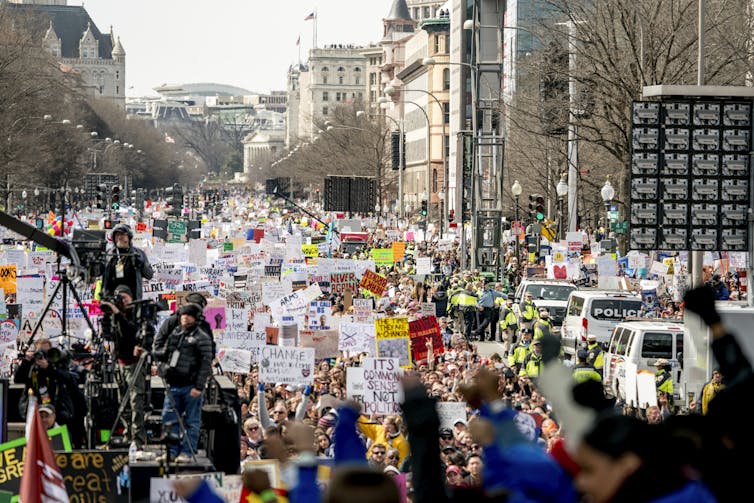Aimee Huff, Oregon State University and Michelle Barnhart, Oregon State University
 Thirty-three Republicans and all but one Democrat in the U.S. House of Representatives agreed to pass additional restrictions on gun ownership as part of a renewed Violence Against Women Act earlier this month.
Thirty-three Republicans and all but one Democrat in the U.S. House of Representatives agreed to pass additional restrictions on gun ownership as part of a renewed Violence Against Women Act earlier this month. This move came on the heels of the February passage of two gun control bills: the Bipartisan Background Checks Act and the Enhanced Background Checks Act, all of which were opposed by the NRA.
As the first gun control legislation to pass either the House or Senate since the 1994 Federal Assault Weapons Ban, the recent bills mark a historic shift in American politics.
We have studied contemporary American gun culture for the past four years, tracing the foundation of the emerging gun control movement. Our research offers insight into the ways that gun violence prevention groups have promoted cultural shifts around guns, and why so many legislators are now willing to broach this contentious issue.
For the past 25 years, gun control has been the untouchable “third rail” of American politics. Even in the face of multiple mass shootings – Columbine, Virginia Tech, Aurora, Sandy Hook, Orlando and Las Vegas, to name a few – very few politicians have declared themselves in favor of gun control. On the other hand, many successful politicians have positioned themselves as “pro-gun.”
By avoiding associating themselves with gun control, politicians have skirted a divisive issue. But they have also perpetuated the notion that gun regulations are not feasible or palatable to American citizens.
Background check bills failed in the 2013 Democrat-led Senate. They failed again in the 2016 Republican-led Senate. That seems surprising given that national polls report that, for the last six years, nine in 10 Americans have supported background check requirements on gun purchases.
The failure of these bills provoked a sense of resignation from many Americans weary of the violence, who feared that if the Sandy Hook shooting hadn’t prompted legislative action, nothing would.
As consumer culture scholars, we find two things particularly notable about the passage of the House bills. First, the gun control movement’s seeds, planted as far back as 1974, have now begun to sprout. Second, passage of the bills is remarkable evidence of this social movement, irrespective of any Senate action or inaction.
The emerging movement
American gun violence has provoked routine public condemnation and support for stronger gun laws.Yet, gun policy experts like Duke University political scientist Kristin Goss have described gun control as America’s “missing movement.” As of 2006, groups of concerned citizens had not gathered the financial resources, strategic framing and incremental policy changes needed to galvanize into a full-fledged movement.
Research on government anti-smoking campaigns has shown that changing the culture requires influencing change at multiple levels, including legislation, business and organization policies and individual behavior.
In recent years, groups like Everytown for Gun Safety and Sandy Hook Promise have worked mostly independently, but in ways that reinforced each other, on issues related to gun violence prevention.
For instance, some groups encouraged voters and state legislators to institute universal background checks and businesses to adopt preventive policies, such as Dick’s Sporting Goods’ decision to stop selling “assault-style” rifles, while others focused on convincing gun owners to store their guns in a locked safe. The groups often used statistics and research data in their efforts.
These gun violence prevention groups have sought incremental policy changes, while also explicitly supporting Americans’ constitutional rights.
This measured, middle-ground approach appears to have laid the necessary scaffolding for the full-fledged movement sparked by the Parkland shooting in February of 2018.
What changed after Parkland
Our research indicates that a critical change happened after Parkland. Parkland survivors galvanized both citizens previously involved in gun violence prevention and a broader range of Americans not with statistics and data, but by employing two powerful and complementary narratives.The first involves hero-kids taking on the infamous gun lobby – a David-and-Goliath story easy to rally behind. The second challenged parents, and young adults who grew up in an age of lockdown drills, to be heroes themselves by voting pro-gun candidates out of office.
The second narrative involves parental duty to protect children. This has been successful for many social movements, and the pro-gun movement is no exception.
A movement’s success can manifest in different forms. Legislation is one such form. Changes in public opinion, individual behaviors or organizational policies, or, more broadly, shifts in the way we talk about social issues are others.
This latter form of change is significant. When a contentious issue shifts from a taboo, fringe or radical topic into the mainstream, public attention moves from a question of “whether” to a question of “how” to address the issue.
The activism in the wake of Parkland appears to have made a difference. Many candidates for the federal elections in 2018 made “common sense gun control” part of their platform. Notably, many of these candidates, like U.S. Reps. Jason Crow and Jennifer Wexton, were elected.
These election results suggest the movement’s efforts in laying the groundwork for cultural change and shifting the social discourse has enabled many Americans to disentangle “gun control” from “anti gun,” and to simultaneously support both the right to bear arms and reasonable restrictions on that right. The movement’s success in doing so has made supporting gun control possible for today’s politicians.
Aimee Huff, Assistant Professor, Marketing, Oregon State University and Michelle Barnhart, Associate Professor of Marketing, Oregon State University
This article is republished from The Conversation under a Creative Commons license. Read the original article.
